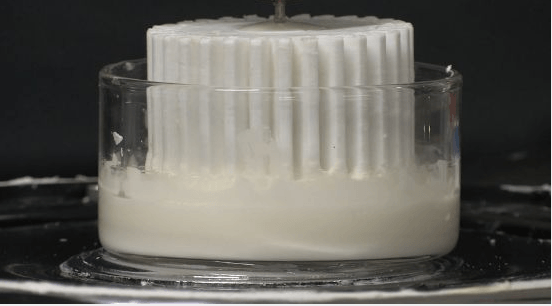Sep 15 2016
Shear thickening – the increase of a liquid’s viscosity through applied force – is a well-known phenomenon. Mix equal parts corn starch and water and you come up with “Oobleck,” a liquid that turns solid the more vigorously you stir it.

Thickening fluids have many technological uses – traction control in vehicles and liquid body armor are two examples – but the effect can be detrimental if the thickening causes clogging in pipes and nozzles. If one could gain control over the thickening process, instead of the thickening process doing the controlling, the potential would exist to solve many processing problems in various industries.
Neil Lin, a graduate student in the field of experimental physics in the lab of associate professor Itai Cohen, and Chris Ness a theoretical physics graduate student in the lab of Jin Sun from the University of Edinburgh, Scotland, have proposed a technique to do just that in a paper, “Tunable shear thickening in suspensions,” published Sept. 12 in the Proceedings of the National Academy of Sciences.
The group – which included professor Michael Cates from the Centre for Mathematical Sciences at the University of Cambridge, England – devised a method to adjust on demand the flowability of a thickening material.
“For a long time, we’ve dealt with strange flow behavior by trying to characterize it and live with it,” Lin said. “But this is actually the first time we’ve shown the ability to take control over the flow behavior and then tailor it.”
Recent work in the Cohen Group has shown that shear thickening is a consequence of particle contact clusters and their alignment along the direction of the flow. These clusters reform continuously during flow and thicken the suspension. The group’s idea: break the particle clusters and make the thickened fluid flow smoothly again.
How Oobleck Works: The Mystery of Thickening Corn Starch
They’ve achieved this by applying oscillation perpendicular to the fluid’s original flow direction, which pulls apart the particles in a cluster. This perturbation must be applied delicately, with a precise combination of high frequency and small amplitude.
The high frequency guarantees disturbance of the clusters before they rearrange into new ones; the limited amplitude prevents the oscillation from creating thickening clusters in the direction of the perturbation.
“This simple disturbance can effectively lower the viscosity of a thickening suspension by about a factor of 100,” Cohen said.
To demonstrate their method, Lin and the group devised a simple experiment – pouring a cornstarch mixture into a container being vibrated by a speaker and dipping the flywheel of a motor into it. The flywheel became stuck and the motor stalled when the speaker was off, but when turned on, the vibrations break up the clusters, the mixture’s viscosity is lowered and the flywheel turns.
“In industry, the only solution to deal with this problem has been to either modify the suspended particles or just water down the material, to dilute the concentration,” Lin said. “But that’s not what we want – we don’t want to compromise anything.”
Cohen said this technique has myriad possibilities in many advanced technological fields, such as 3-D printing, energy storage and robotics.
“We will be able to 3-D-print very concentrated materials – cement, conducting suspensions comprised of metal particles, even chocolate,” he said. “We can also imagine building robotic arms with varying rigidities in their joints and grippers.”
This work was supported by grants from the National Science Foundation and made use of the Cornell Center for Materials Research Shared Facilities, which also is supported by the NSF.